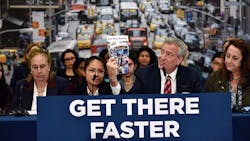New York City Mayor Bill de Blasio has revealed details of his strategic mobility plan, 2019 OneNYC, which he says will improve and speed up how people and buses move through the city.
The plan includes details on how the city’s Department of Transportation will implement the Bus Action Plan; an initiative to triple the number of businesses switching to off-hour deliveries and pursuit of new pedestrian priority zones around Lower Manhattan. The mayor said these measures will help New Yorkers get around and complement the implementation of congestion pricing in early 2021.
“Making it easier to get around our city means New Yorkers have more time for what matters most – for their family and themselves,” said Mayor de Blasio. “These measures are part of our OneNYC strategy to build a fairer, better city for all. They complement congestion pricing, helping us fix our subways and reduce traffic delays to get our city moving.”
In his 2019 State of the City address, Mayor de Blasio announced a citywide goal of improving bus speeds by 25 percent by 2020. Earlier this year, the city announced plans to set up seven new New York City Police Department tow teams that will operate in all five boroughs and tow cars parked along bus routes with dedicated bus lanes. The Better Buses Action Plan identifies the specific routes and projects the city will undertake in 2019 to increase bus speeds in all five boroughs. These projects include:
Manhattan: 42nd Street, 12th Avenue to FDR Drive; 2 miles
Total daily ridership: 16,000
Potential Improvements:
• Upgrade curbside bus lane to offset lane in at least one direction
• Update curb management along the corridor to prioritize transit priority, pedestrian space, and loading needs
• Extend/install turn bays at select locations and install turn bans at select locations to benefit the flow of buses and other traffic
• Adjust signal timing to improve crosstown travel
Bronx: Webster Avenue, 176th Street to 174th Street; .25 miles
Total daily ridership: 21,000
Potential Improvements:
• Add southbound offset bus lane between E 176th St and E 174th St
• Add physical barrier to separate bus and right turning movements
• Adjust signal timing to improve safety and vehicle flow
Queens: Rockaway Beach Boulevard, Beach 116th Street to Beach 73rd Street; 3.7 miles
Total daily ridership: 36,000
Potential Improvements:
• Implement pedestrian safety improvements at intersections along the corridor
• Construct sidewalks to make bus stops at Beach 73rd St and Beach 67th St accessible
• Install offset and curbside bus lanes on portions of the corridor
Brooklyn: Livingston Street, Boerum Place to Flatbush Avenue
Total daily ridership: 63,000
Potential Improvements:
• Add dedicated westbound right turn arrow and signal phase to help buses turning right from westbound Livingston St onto Boerum Pl
• Refresh existing bus lanes and extend bus lane hours
• Upgrade bus lanes to protected bus lanes with physical barriers to prevent illegal parking and standing
Staten Island: Narrows Road at Hylan Boulevard
Total daily ridership: 33,000
Potential Improvements:
• Relocate the northbound S78 bus stop from the south side of Narrows Rd S to the north side to improve bus operations and safety
• Reverse direction of Hylan Blvd (east leg) from northbound to southbound, from Narrows Rd S to Olga Pl, to reduce congestion and make it easier for buses and other traffic on Narrows Rd S to merge onto the Staten Island Expressway on-ramp
• Investigate a leading pedestrian signal (LPI) for the east crosswalk to give pedestrians a head start on crossing the street to reach the S78 bus stop
• Coordinate with NYSDOT to move the existing bus stop on the south side of Narrows Rd S/Hylan Blvd one block to the west to improve safety, to better position buses to merge onto the Staten Island Expy and alleviate traffic congestion
“Public transportation is the lifeblood of our city, but congested streets and crowded sidewalks negatively impact safety and accessibility in our communities. That’s why we’re thrilled that the city, through OneNYC, is taking steps to speed up buses and better manage delivery times,” said Daniel Zarrilli, NYC’s OneNYC director and chief climate policy advisor. “These measures announced today, including a bold experiment to prioritize pedestrians in Lower Manhattan, send a message to the globe and help to make our city safer and easier to get around while ensuring efficient mobility for all.”
In addition to improving bus movement, Mayor de Blasio aims to triple the number of businesses that accept off-hour deliveries in the Central Business District to 1,500, which would be an increase from the current number of slightly more than 500.
The third part of Mayor de Blasio’s mobility plan would explore options for creating new pedestrian priority streets in Lower Manhattan, where streets are narrow and sidewalks are often overcrowded.
"The changes included in the Better Buses Action Plan will help New Yorkers get around more easily," said State Senator Robert Jackson. "From monitored bus lanes to greater efficiency in the Bronx and Queens, from new pedestrian spaces downtown to increased off-hour deliveries for businesses, these reforms will clean up our streets and speed up traffic.
About the Author

Mischa Wanek-Libman
Group Editorial Director
Mischa Wanek-Libman is director of communications with Transdev North America. She has more than 20 years of experience working in the transportation industry covering construction projects, engineering challenges, transit and rail operations and best practices.
Wanek-Libman has held top editorial positions at freight rail and public transportation business-to-business publications including as editor-in-chief and editorial director of Mass Transit from 2018-2024. She has been recognized for editorial excellence through her individual work, as well as for collaborative content.
She is an active member of the American Public Transportation Association's Marketing and Communications Committee and served 14 years as a Board Observer on the National Railroad Construction and Maintenance Association (NRC) Board of Directors.
She is a graduate of Drake University in Des Moines, Iowa, where she earned a Bachelor of Arts degree in Journalism and Mass Communication.
